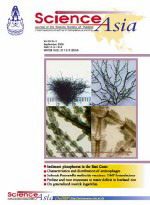ThaiScience
ThaiScience
SCIENCE ASIA
Volume 46, No. 03, Month JUNE, Year 2020, Pages 263 - 270
Analysis of expression levels of genes involved in the nacre color of hyriopsis cumingii shell
Zhi Gang Wang, Yi Yun Mei, Rong Quan Zheng, Yuan Yuan Mao, Gen Fang Zhang, Rong Hui Ye
Abstract Download PDF
Freshwater mussel Hyriopsis cumingii is ubiquitous in China and commercially valuable for freshwater pearl production. Donor pearl mussel or oyster shell nacre color considerably affects pearl color, but the molecular mechanism underlying pearl color remains unclear. Mussels with purple and white inner-shell colors were selected, and five genes related to nacreous layer color formation were identified through comparative transcriptome analysis. Real-time quantitative analysis indicated that HcTyr1 encoding tyrosinase is involved in black pigment synthesis. HcTyr1 expression in rear edge films was higher in the purple mussels (p < 0.05). The expression in the posterior and anterior mantle pallial of HcAst, which encodes shrimp erythropoietin, was higher in the purple mussels (p < 0.01). HcAst expression in the central membrane was also higher in the purple mussels (p < 0.05). The expression of HcCyt, which encodes cytochrome P450, was higher in the central membranes of the purple mussels than in the posterior and anterior mantle pallial and the central membranes of the white mussels (p <0.01). The expression in the posterior mantle pallial of HcTDO, which encodes tryptophan oxygenase involving in ophthalmic lutein synthesis, was significantly higher in the purple mussels (p < 0.01). No difference in expression regularity in the outer mantle of HcUROD which encodes urine porphyrin decarboxylase participating in heme synthesis was observed among the mussels, and the expression was higher in the posterior marginal membrane than in the central membrane (p < 0.01). These studied genes are involved in nacre color formation in H. cumingii.
Keywords
Hyriopsis cumingii, nacre color, gene, differential expressionSCIENCE ASIA
Published by : The Science Society of Thailand
Contributions welcome at : http://www.scienceasia.org/
